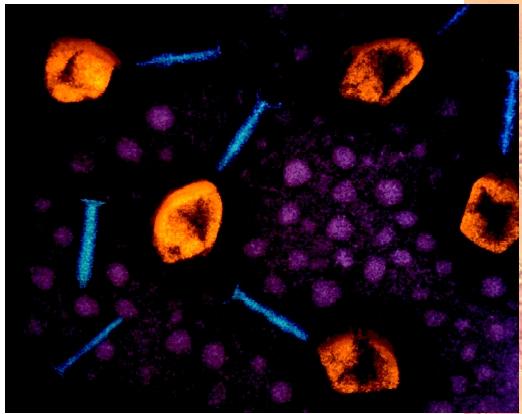Bacterial Viruses
There are viruses that infect all types of cells: animal cells, plant cells, and unicellular organisms. Those that infect bacteria are called bacteriophage or just phage ( phage means "to eat"). Bacteriophage exist as inert particles when they are outside of bacterial cells. They possess complex protein coats with defined structure and may also have tail structures. The protein coat, or capsid, surrounds the deoxyribonucleic acid (DNA) or ribonucleic acid (RNA) molecules that make up the bacteriophage genome . Phage genomes can be single stranded or double stranded, and are either circular or linear. Different bacteriophage can encode as few as four proteins or as many as one hundred in their genome.
Phage are similar to animal and plant viruses in that they are not alive, since they cannot replicate themselves or conduct metabolic processes. All phage require bacterial cells for reproduction, but each phage type exhibits a defined host range. Some phage are very specific for one or two closely related bacterial species, while others can infect and replicate in a variety of bacterial cells. The host cell functions required for bacteriophage reproduction define host range. These include attachment to specific molecules on the bacterial cell surface, injection of the bacteriophage DNA into the bacterial cell cytoplasm , avoidance of host cell defenses, proper expression and regulation of bacteriophage genes , production and assembly of the capsid, replication of the phage nucleic acid (DNA or RNA), packaging the nucleic acid into the capsid, and exit from the bacterial cell.
The bacteriophage that infect the bacterium Escherichia coli can be used to illustrate many of the properties of different bacteriophage. One of the most well-studied bacteriophage is bacteriophage λ. The λ genome exists as a linear, doubled-stranded DNA molecule in the bacteriophage particle. There are 48,514 base pairs of DNA that encode about 50 genes that define the λ genome. λ phage bind to a receptor on the E. coli cell surface that includes a protein involved in transporting the sugar molecule, maltose. (It is common for viruses to use cellular molecules designed for another function for their own ends.)
The λ genome is injected through the cell envelope into the cytoplasm, where it is converted from a linear to circular form. At this point a choice is made between two different programs: a lytic or lysogenic state. When λ phage undergo lytic growth, replication produces hundreds of copies of its genome and phage genes produce the proteins that make up the capsid, in which the phage genome is inserted to make the mature phage particles. These phage particles are released by enzymes that break open the bacterial cell. Lysogeny is a dormant state, where the λ genome becomes part of the bacterial genome and is inherited by the bacterial offspring as a prophage. Bacteriophage that produce lysogeny, like λ, are called temperate since they do not harm the bacteria, while those that can only replicate are called virulent, since they commonly kill the host cell.
There are many virulent phage in E. coli. The T even phage (such as T2, T4) and T odd phage (such as T1, T3) always replicate themselves and lyse the bacterial cell. In contrast, filamentous phage (for example, M13, fd) always replicate but produce new phage particles by extruding out of the bacterial membrane and never destroy the bacterial cell. When a prophage

SEE ALSO Bacterial Cell ; Bacterial Genetics ; DNA ; DNA Viruses ; Replication ; Retrovirus ; Virus
Hank Seifert
Bibliography
Tortora, Gerard J., Berdell R. Funke, Christine L. Case. Microbiology: An Introduction. Redwood City: CA: Benjamin/Cummings Publishing Company, Inc., 2001.
Comment about this article, ask questions, or add new information about this topic: